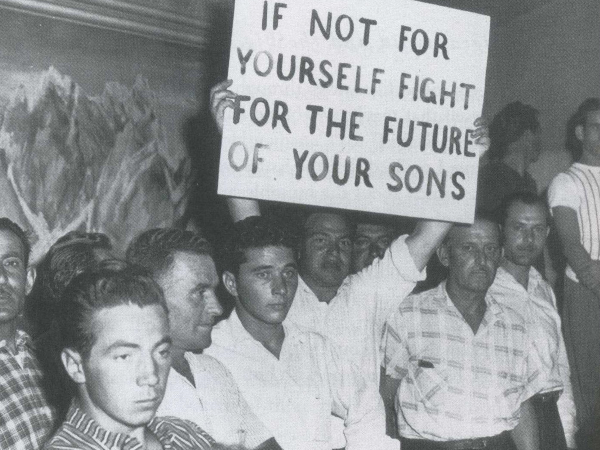
The exploitation of immigrant workers in Toronto’s booming post-war residential construction industry led to courageous efforts to organize. Repeated attempts to gain union standards were defeated by employer resistance, unjust laws and ruthless competition between subcontractors. The March 17th Hoggs Hollow tragedy sparked an upsurge in the Italian community demanding fair treatment in their adopted country.
On August 1, 1960, at a meeting attended by 3,000 residential construction workers at the Lansdowne Theatre, the leaders of the Brandon Union Group launched their first illegal strike. Nearly all residential building projects in metropolitan Toronto were stopped as a result of this strike, leading to contracts which were celebrated by the workers who marched with pride for the first time in that year’s Labour Day parade. But the terms of the settlement were soon ignored by contractors.
In 1961 residential construction workers went on a second unlawful strike in order to win decent wages and conditions. Over 4,300 immigrant workers attended the first meeting at Lansdowne Theatre on May 29, 1961. That day, 200 flying squads travelled across metropolitan Toronto carrying over 2,000 picketers. Other unions, like the Labourers’ Local 183, supported the strike, expanding it to commercial and heavy sectors.
The aggressive tactics used in this strike were similar to the previous one. This time the police intervention led to various confrontations and 200 arrests. On June 26th the Building Trades Council shut down every construction project in the city for twenty-four hours and held a solidarity rally at the CNE Grandstand. The rally was attended by more than 17,000 workers and a long list of prominent labour leaders.
The strike lasted 48 days, during which various politicians were asked to intervene, including the Ontario Premier Leslie Frost. The strike ended on July 15, and resulted in a Royal Commission on Construction Industry whose recommendations led to vital changes to labour law, organizing rights, and a new Construction Safety Act.